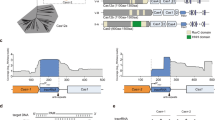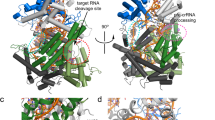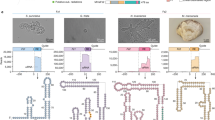Abstract
Specialized RNA endonucleases for the maturation of clustered regularly interspaced short palindromic repeat (CRISPR)-derived RNAs (crRNAs) are critical in CRISPR–CRISPR-associated protein (Cas) defence mechanisms. The Cas6 and Cas5d enzymes are the RNA endonucleases in many class 1 CRISPR–Cas systems. In some class 2 systems, maturation and effector functions are combined within a single enzyme or maturation proceeds through the combined actions of RNase III and trans-activating CRISPR RNAs (tracrRNAs). Three separate CRISPR–Cas systems exist in the cyanobacterium Synechocystis sp. PCC 6803. Whereas Cas6-type enzymes act in two of these systems, the third, which is classified as subtype III-B variant (III-Bv), lacks cas6 homologues. Instead, the maturation of crRNAs proceeds through the activity of endoribonuclease E, leaving unusual 13- and 14-nucleotide-long 5′-handles. Overexpression of RNase E leads to overaccumulation and knock-down to the reduced accumulation of crRNAs in vivo, suggesting that RNase E is the limiting factor for CRISPR complex formation. Recognition by RNase E depends on a stem-loop in the CRISPR repeat, whereas base substitutions at the cleavage site trigger the appearance of secondary products, consistent with a two-step recognition and cleavage mechanism. These results suggest the adaptation of an otherwise very conserved housekeeping enzyme to accommodate new substrates and illuminate the impressive plasticity of CRISPR–Cas systems that enables them to function in particular genomic environments.
This is a preview of subscription content, access via your institution
Access options
Access Nature and 54 other Nature Portfolio journals
Get Nature+, our best-value online-access subscription
$29.99 / 30 days
cancel any time
Subscribe to this journal
Receive 12 digital issues and online access to articles
$119.00 per year
only $9.92 per issue
Buy this article
- Purchase on Springer Link
- Instant access to full article PDF
Prices may be subject to local taxes which are calculated during checkout






Similar content being viewed by others
References
Bhaya, D., Davison, M. & Barrangou, R. CRISPR–Cas systems in Bacteria and Archaea: versatile small RNAs for adaptive defense and regulation. Annu. Rev. Genet. 45, 273–297 (2011).
Grissa, I., Vergnaud, G. & Pourcel, C. The CRISPRdb database and tools to display CRISPRs and to generate dictionaries of spacers and repeats. BMC Bioinforma. 8, 172 (2007).
Jansen, R., Embden, J. D. A., van Gaastra, W. & Schouls, L. M. Identification of genes that are associated with DNA repeats in prokaryotes. Mol. Microbiol. 43, 1565–1575 (2002).
Lange, S. J., Alkhnbashi, O. S., Rose, D., Will, S. & Backofen, R. CRISPRmap: an automated classification of repeat conservation in prokaryotic adaptive immune systems. Nucleic Acids Res. 41, 8034–8044 (2013).
Makarova, K. S. et al. An updated evolutionary classification of CRISPR–Cas systems. Nat. Rev. Microbiol. 13, 722–736 (2015).
Hochstrasser, M. L. & Doudna, J. A. Cutting it close: CRISPR-associated endoribonuclease structure and function. Trends Biochem. Sci. 40, 58–66 (2015).
Westra, E. R., Dowling, A. J., Broniewski, J. M. & van Houte, S. Evolution and ecology of CRISPR. Annu. Rev. Ecol. Evol. Syst. 47, 307–331 (2016).
Brouns, S. J. J. et al. Small CRISPR RNAs guide antiviral defense in prokaryotes. Science 321, 960–964 (2008).
Hale, C., Kleppe, K., Terns, R. M. & Terns, M. P. Prokaryotic silencing (psi)RNAs in Pyrococcus furiosus. RNA 14, 2572–2579 (2008).
Charpentier, E., Richter, H., van der Oost, J. & White, M. F. Biogenesis pathways of RNA guides in archaeal and bacterial CRISPR–Cas adaptive immunity. FEMS Microbiol. Rev. 39, 428–441 (2015).
Hale, C. R. et al. RNA-guided RNA cleavage by a CRISPR RNA–Cas protein complex. Cell 139, 945–956 (2009).
Przybilski, R. et al. Csy4 is responsible for CRISPR RNA processing in Pectobacterium atrosepticum. RNA Biol. 8, 517–528 (2011).
Karginov, F. V. & Hannon, G. J. The CRISPR system: small RNA-guided defense in Bacteria and Archaea. Mol. Cell. 37, 7–19 (2010).
Carte, J., Wang, R., Li, H., Terns, R. M. & Terns, M. P. Cas6 is an endoribonuclease that generates guide RNAs for invader defense in prokaryotes. Genes. Dev. 22, 3489–3496 (2008).
Nam, K. H. et al. Cas5d protein processes pre-crRNA and assembles into a cascade-like interference complex in subtype I-C/Dvulg CRISPR–Cas system. Structure 20, 1574–1584 (2012).
Punetha, A., Sivathanu, R. & Anand, B. Active site plasticity enables metal-dependent tuning of Cas5d nuclease activity in CRISPR–Cas type I-C system. Nucleic Acids Res. 42, 3846–3856 (2014).
Staals, R. H. J. et al. Structure and activity of the RNA-targeting type III-B CRISPR–Cas complex of Thermus thermophilus. Mol. Cell. 52, 135–145 (2013).
Shmakov, S. et al. Discovery and functional characterization of diverse class 2 CRISPR–Cas systems. Mol. Cell. 60, 385–397 (2015).
Koonin, E. V. et al. Diversity, classification and evolution of CRISPR–Cas systems. Curr. Opin. Microbiol. 37, 67–78 (2017).
Fonfara, I., Richter, H., Bratovič, M., Le Rhun, A. & Charpentier, E. The CRISPR-associated DNA-cleaving enzyme Cpf1 also processes precursor CRISPR RNA. Nature 532, 517–521 (2016).
East-Seletsky, A. et al. Two distinct RNase activities of CRISPR–C2c2 enable guide-RNA processing and RNA detection. Nature 538, 270–273 (2016).
Abudayyeh, O. O. et al. C2c2 is a single-component programmable RNA-guided RNA-targeting CRISPR effector. Science 353, aaf5573 (2016).
Scholz, I., Lange, S. J., Hein, S., Hess, W. R. & Backofen, R. CRISPR–Cas systems in the cyanobacterium Synechocystis sp. PCC6803 exhibit distinct processing pathways involving at least two Cas6 and a Cmr2 protein. PLoS. ONE 8, e56470 (2013).
Reimann, V. et al. Structural constraints and enzymatic promiscuity in the Cas6-dependent generation of crRNAs. Nucleic Acids Res. 45, 915–925 (2017).
Carte, J., Pfister, N. T., Compton, M. M., Terns, R. M. & Terns, M. P. Binding and cleavage of CRISPR RNA by Cas6. RNA 16, 2181–2188 (2010).
Wang, R., Preamplume, G., Terns, M. P., Terns, R. M. & Li, H. Interaction of the Cas6 riboendonuclease with CRISPR RNAs: recognition and cleavage. Structure 19, 257–264 (2011).
Gesner, E. M., Schellenberg, M. J., Garside, E. L., George, M. M. & MacMillan, A. M. Recognition and maturation of effector RNAs in a CRISPR interference pathway. Nat. Struct. Mol. Biol. 18, 688–692 (2011).
Schein, A., Sheffy-Levin, S., Glaser, F. & Schuster, G. The RNase E/G-type endoribonuclease of higher plants is located in the chloroplast and cleaves RNA similarly to the E. coli enzyme. RNA 14, 1057–1068 (2008).
Horie, Y. et al. Dark-induced mRNA instability involves RNase E/G-type endoribonuclease cleavage at the AU-box and SD sequences in cyanobacteria. Mol. Genet. Genom. 278, 331–346 (2007).
Mohanty, B. K., Petree, J. R. & Kushner, S. R. Endonucleolytic cleavages by RNase E generate the mature 3′ termini of the three proline tRNAs in Escherichia coli. Nucleic Acids Res. 44, 6350–6362 (2016).
Jiang, X., Diwa, A. & Belasco, J. G. Regions of RNase E important for 5′-end-dependent RNA cleavage and autoregulated synthesis. J. Bacteriol. 182, 2468–2475 (2000).
Chao, Y. et al. In vivo cleavage map illuminates the central role of RNase E in coding and non-coding RNA pathways. Mol. Cell. 65, 39–51 (2017).
Zhang, J., Graham, S., Tello, A., Liu, H. & White, M. F. Multiple nucleic acid cleavage modes in divergent type III CRISPR systems. Nucleic Acids Res. 44, 1789–1799 (2016).
Rott, R., Zipor, G., Portnoy, V., Liveanu, V. & Schuster, G. RNA polyadenylation and degradation in cyanobacteria are similar to the chloroplast but different from Escherichia coli. J. Biol. Chem. 278, 15771–15777 (2003).
Sharma, K. et al. Analysis of protein–RNA interactions in CRISPR proteins and effector complexes by UV-induced cross-linking and mass spectrometry. Methods 89, 138–148 (2015).
Kramer, K. et al. Photo-cross-linking and high-resolution mass spectrometry for assignment of RNA-binding sites in RNA-binding proteins. Nat. Methods 11, 1064–1070 (2014).
Zhang, J.-Y. et al. RNase E forms a complex with polynucleotide phosphorylase in cyanobacteria via a cyanobacterial-specific nonapeptide in the noncatalytic region. RNA 20, 568–579 (2014).
Hein, S., Scholz, I., Voß, B. & Hess, W. R. Adaptation and modification of three CRISPR loci in two closely related cyanobacteria. RNA Biol. 10, 852–864 (2013).
Loedige, I. et al. The NHL domain of BRAT is an RNA-binding domain that directly contacts the hunchback mRNA for regulation. Genes. Dev. 28, 749–764 (2014).
Schultz, A., Nottrott, S., Watkins, N. J. & Lührmann, R. Protein–protein and protein–RNA contacts both contribute to the 15.5K-mediated assembly of the U4/U6 snRNP and the box C/D snoRNPs. Mol. Cell. Biol. 26, 5146–5154 (2006).
Tamulaitis, G., Venclovas, Č. & Siksnys, V. Type III CRISPR–Cas immunity: major differences brushed aside. Trends Microbiol. 25, 49–61 (2017).
Kazlauskiene, M., Tamulaitis, G., Kostiuk, G., Venclovas, Č. & Siksnys, V. Spatiotemporal control of type III-A CRISPR–Cas immunity: coupling DNA degradation with the target RNA recognition. Mol. Cell. 62, 295–306 (2016).
Marraffini, L. A. & Sontheimer, E. J. CRISPR interference: RNA-directed adaptive immunity in Bacteria and Archaea. Nat. Rev. Genet. 11, 181–190 (2010).
Kopf, M. et al. Comparative genome analysis of the closely related Synechocystis strains PCC 6714 and PCC 6803. DNA Res. 21, 255–266 (2014).
Deltcheva, E. et al. CRISPR RNA maturation by trans-encoded small RNA and host factor RNase III. Nature 471, 602–607 (2011).
Karvelis, T. et al. crRNA and tracrRNA guide Cas9-mediated DNA interference in Streptococcus thermophilus. RNA Biol. 10, 841–851 (2013).
Li, H. Structural principles of CRISPR RNA processing. Structure 23, 13–20 (2015).
Fonfara, I. et al. Phylogeny of Cas9 determines functional exchangeability of dual-RNA and Cas9 among orthologous type II CRISPR–Cas systems. Nucleic Acids Res. 42, 2577–2590 (2014).
Sesto, N. et al. A PNPase dependent CRISPR system in Listeria. PLoS. Genet. 10, e1004065 (2014).
Walker, F. C., Chou-Zheng, L., Dunkle, J. A. & Hatoum-Aslan, A. Molecular determinants for CRISPR RNA maturation in the Cas10–Csm complex and roles for non-Cas nucleases. Nucleic Acids Res. 45, 2112–2123 (2016).
Stazic, D., Lindell, D. & Steglich, C. Antisense RNA protects mRNA from RNase E degradation by RNA–RNA duplex formation during phage infection. Nucleic Acids Res. 39, 4890–4899 (2011).
Sakurai, I. et al. Positive regulation of psbA gene expression by cis-encoded antisense RNAs in Synechocystis sp. PCC 6803. Plant Physiol. 160, 1000–1010 (2012).
Kuchmina, E., Wallner, T., Kryazhov, S., Zinchenko, V. V. & Wilde, A. An expression system for regulated protein production in Synechocystis sp. PCC 6803 and its application for construction of a conditional knockout of the ferrochelatase enzyme. J. Biotechnol. 162, 75–80 (2012).
Yao, L., Cengic, I., Anfelt, J. & Hudson, E. P. Multiple gene repression in Cyanobacteria using CRISPRi. ACS Synth. Biol. 5, 207–212 (2016).
Blin, K., Pedersen, L. E., Weber, T. & Lee, S. Y. CRISPy-web: an online resource to design sgRNAs for CRISPR applications. Synth. Syst. Biotechnol. 1, 118–121 (2016).
Larson, M. H. et al. CRISPR interference (CRISPRi) for sequence-specific control of gene expression. Nat. Protoc. 8, 2180–2196 (2013).
Hofacker, I. L. Vienna RNA secondary structure server. Nucleic Acids Res. 31, 3429–3431 (2003).
Darty, K., Denise, A. & Ponty, Y. VARNA: interactive drawing and editing of the RNA secondary structure. Bioinformatics 25, 1974–1975 (2009).
Acknowledgements
We thank O. Alkhnbashi and C. Steglich for helpful comments, U. Ruppert for technical assistance, M. Asayama and E. P. Hudson for the provided plasmids. Financial support from the German Research Foundation programme FOR1680 'Unravelling the Prokaryotic Immune System' (grants HE 2544/8-2 and UR225/1-2) to W.R.H. and H.U. is greatly acknowledged.
Author information
Authors and Affiliations
Contributions
J.B. and W.R.H. designed the work. The protein–RNA cross-linking experiments and identification of cross-linked peptide–RNA bonds were performed by K.S. and H.U. The RNase E overexpression and partial deletion strains were constructed by A.W. The ∆C1 and ∆C1∆C2 deletion strains were constructed by V.R. All other experiments were carried out by J.B. J.B., K.S. and W.R.H. analysed the data. J.B. and W.R.H. wrote the paper with contributions from all authors.
Corresponding author
Additional information
Publisher’s note: Springer Nature remains neutral with regard to jurisdictional claims in published maps and institutional affiliations.
Supplementary information
Supplementary Information
Supplementary Figures 1–6, Supplementary Table 1, raw full length gels and blots.
Rights and permissions
About this article
Cite this article
Behler, J., Sharma, K., Reimann, V. et al. The host-encoded RNase E endonuclease as the crRNA maturation enzyme in a CRISPR–Cas subtype III-Bv system. Nat Microbiol 3, 367–377 (2018). https://doi.org/10.1038/s41564-017-0103-5
Received:
Accepted:
Published:
Issue Date:
DOI: https://doi.org/10.1038/s41564-017-0103-5
This article is cited by
-
Stem-loop structures control mRNA processing of the cellulosomal cip-cel operon in Ruminiclostridium cellulolyticum
Biotechnology for Biofuels and Bioproducts (2023)
-
Digging into the lesser-known aspects of CRISPR biology
International Microbiology (2021)
-
Metabolic Engineering and Synthetic Biology of Cyanobacteria for Carbon Capture and Utilization
Biotechnology and Bioprocess Engineering (2020)
-
Divergent methylation of CRISPR repeats and cas genes in a subtype I-D CRISPR-Cas-system
BMC Microbiology (2019)
-
Kidnapping der wirtseigenen Nuklease RNase E durch ein CRISPR-Cas-System
BIOspektrum (2019)



